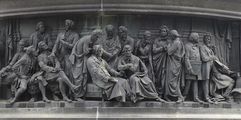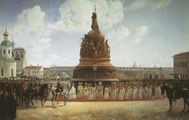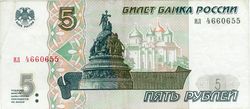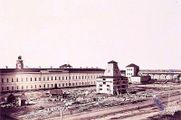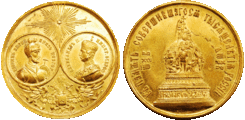ألفية روسيا
58°31′16.05″N 31°16′30.87″E / 58.5211250°N 31.2752417°E
 ألفية روسيا (1862)، مع Saint Sophia Cathedral في الخلفية. الصف العلوي من الشخصيات هو مصبوب في المحيط والصف الأسفل هو نحت بارز. |
ألفية روسيا (بالروسية Тысячелетие России؛ إنگليزية: Millennium of Russia) هو نصب برونزي في كرملن نوڤگورود. وقد أقيم في 1862 في الذكرى الألفية لوصول روريك إلى نوڤگورود، وهو الحدث الذي يُعتبر تقليدياً نقطة بداية تاريخ الدولة الروسية.
A competition to design the monument was held in 1859. An architect Viktor Hartmann and an artist Mikhail Mikeshin were declared the winners. Mikeshin's design called for a grandiose, 15-metre-high bell crowned by a cross symbolizing the tsar's power. The bell was to be encircled with several tiers of sculptures representing Russian monarchs, clerics, generals, and artists active during various periods of Russian history.
Mikeshin himself was no sculptor, therefore the 129 individual statues for the monument were made by the leading Russian sculptors of the day, including his friend Ivan Schroeder and the celebrated Alexander Opekushin. Rather unexpectedly for such an official project, the tsars and commanders were represented side by side with sixteen eminent personalities of Russian culture: Lomonosov, Pushkin, Lermontov, Gogol, Karl Brullov, Mikhail Glinka, etc. As for the Russian rulers, Ivan the Terrible is famously absent from the monument due to his role in the 1570 pillage and massacre of Novgorod by the Oprichnina. Alongside the Muscovite princes, the mediaeval Lithuanian dynasts such as Gediminas or Vytautas the Great who reigned over the Eastern Slavs of the present-day Belarus and Ukraine are represented.
The most expensive Russian monument up to that time, it was erected at a cost of 400,000 roubles, mostly raised by public subscription. In order to provide an appropriate pedestal for the huge sculpture, sixteen blocks of Sortavala granite were brought to Novgorod, each weighing in excess of 35 tons. The bronze monument itself weighs 100 tons.
At the time when the monument was inaugurated, many art critics felt that it was overloaded with figures. Supporters regard Mikeshin's design as harmonious with the medieval setting of the Kremlin, and subtly accentuating the vertical thrust and grandeur of the nearby 11th-century Saint Sophia Cathedral.
أثناء الحرب العالمية الثانية، فكك النازيون النصب، وحضـّروه ليـُنقلوه إلى ألمانيا. إلا أن الجيش الأحمر استعاد السيطرة على نوڤگورود وأعيد ترميم النصب وافتـُتـِح للعامة في 1944. وصدرت عملة تذكارية من فئة 5-روبل في الاتحاد السوڤيتي في 1988 تخليداً للنصب.
المستوى الأوسط
| الصورة | الاسم | الاسم بالروسية | السنة التاريخية | الوصف |
|---|---|---|---|---|
 |
The arrival of the Varangians in Rus | Призвание варягов на Русь | 862 | The statue of the first warrior prince Rurik with helmet and shield with the inscription "year 6370" (since the creation of the world). Rurik wears a fur on his shoulders, behind him the pagan Slavic god Veles can be seen. The figure looks south-west, in the direction of Kiev. |
 |
The Christianization of Rus | Крещение Руси | 988 | في الوسط، يمكن العثور على الأمير الأكبر لكييڤ ڤلاديمير الأكبر، رافعاً صليباً أرثوذكسيا. وبجانبه إمرأة تحمل طفلها للتعميد وسلاڤي يتبرأ من الإله الوثني پـِرون. التشكيل ينظر في اتجاه الجنوب الشرقي. |
 |
بداية طرد التتار | Начало изгнания татар | 1380 | Dmitry Donskoi, the victor in the Battle of Kulikovo, holds a Russian mace in his right hand. At his feet lies Mamai, the defeated warlord of the Golden Horde. In the left hand Dmitry Donskoi holds a captured bunchuk, the Tatar symbol of power. The composition looks east. |
 |
تأسيس قيصرية روسية مستقلة | Основание самодержавного царства Русского | 1491 | إيڤان الأكبر في رداء الأباطرة البيزنطيين مع Monomach's Cap. In his hands he holds a scepter and a globus cruciger. In front of him, a Tatar is kneeling, beside him, a Lithuanian is lying, representing Grand Duchy of Lithuania, as well as a Teutonic knight with a broken sword, representing the Order of الفرسان التيوتون. The composition looks north-east. |
 |
تنصيب أسرة رومانوڤ على العرش | Начало династии Романовых | 1613 | القيصر الشاب ميخائيل من روسيا يرتقي عرش روسيا بعد التغلب على زمن الشدائد. Prince Dmitry Pozharsky who represents the nobility protects him with his sword while Kuzma Minin who represents the people offers him the Monomach's Cap and the scepter. In the background, a figure of a Siberian Cossack can be found which symbolizes the colonization of Siberia to come. |
 |
خلق الامبراطورية الروسية | Образование Российской империи | 1721 | Peter the Great with laurel wreath and scepter in the right hand is supported by an angel showing him the way to the north-west where the future city of سانت پطرسبورگ shall be founded. At Peter's feet, defeated Swede can be found trying to protect his torn flag. This symbolizes the Russian victory in the Great Northern War. The composition looks north-west. |
المستوى الأسفل
| رجال التنوير: | رجال الدولة: | العسكر والأبطال: | الكتاب والفنانون: | ||||
 |
Cyril and Methodius, missionaries of Slavs |  |
ياروسلاڤ الحكيم، Grand Prince of Kiev |  |
سڤياتوسلاڤ الأول من كييڤ, Grand Prince of Kiev |  |
ميخائيل لومونوسوڤ، متعدد المواهب |
 |
Olga of Kiev, Grand Princess of Kiev |  |
Vladimir Monomakh, Grand Prince of Kiev |  |
Mstislav Mstislavich, Prince of Novgorod and Galicia |  |
Denis Fonvizin, playwright |
 |
Vladimir the Great, Grand Prince of Kiev |  |
Gediminas, Grand Prince of Lithuania |  |
Daniel of Galicia, Prince of Galicia |  |
Alexander Kokorinov, architect |
 |
Abraham of Rostov, bishop of Rostov |  |
Algirdas, Grand Prince of Lithuania |  |
Daumantas, Prince of Pskov |  |
Gavrila Derzhavin, poet and statesman |
 |
Anthony of Kiev, founder of the Monastery of the Caves |  |
Vytautas, Grand Prince of Lithuania |  |
Alexander Nevsky, Grand Prince of Vladimir |  |
Fyodor Volkov, actor |
 |
Theodosius of Kiev, Kievan monk |  |
Ivan the Great, Grand Prince of Moscow |  |
Michael of Tver, Prince of Tver |  |
Nikolai Karamzin, playwright and historian |
 |
Kuksha of the Kiev Caves, Kievan monk |  |
Sylvester, clergyman and statesman |  |
Dmitry Donskoi, Grand Prince of Moscow |  |
Ivan Krylov, poet of fables |
 |
Nestor the Chronicler, chronicler of the Russian history |  |
Anastasia Romanovna, first wife of Ivan the Terrible |  |
Kęstutis, Grand Prince of Lithuania |  |
Vasily Zhukovsky, poet and translator |
 |
Cyril of White Lake, Founder of the Kirillo-Belozersky Monastery |  |
Alexey Adashev, Ivan IV's bosom friend and advisor |  |
Daniil Kholmsky, general |  |
Nikolay Gnedich, Poet and translator |
 |
Stephen of Perm, Bishop and Missionary of Perm |  |
Hermogenes, Patriarch of Moscow |  |
Mikhail Vorotynsky، فيلد مارشال |  |
Aleksandr Griboyedov, Writer and Diplomat |
 |
Alexius of Moscow, Metropolitan of Kiev and Moscow |  |
Michael Romanov, first Romanov tsar |  |
Daniil Shchenya, military leader |  |
Mikhail Lermontov, poet and writer |
 |
Sergius of Radonezh, spiritual leader |  |
Filaret, Patriarch of Moscow |  |
Marfa Boretskaya, Posadnik of Novgorod |  |
Alexander Pushkin, poet and writer |
 |
Peter Mogila, Metropolitan of Kiev |  |
Afanasy Ordin-Nashchokin, Diplomat |  |
Yermak Timofeyevich, Cossack leader |  |
Nikolai Gogol, Writer |
 |
Zosima of Solovki, Founder of the Solovetsky Monastery |  |
Artamon Matveyev, Statesman and Diplomat |  |
Mikhail Skopin-Shuisky, military leader |  |
Mikhail Glinka, Composer |
 |
Maximus the Greek, Writer and scholar |  |
Alexei I, Tsar |  |
Dmitry Pozharsky, Prince |  |
Karl Briullov, Painter |
 |
Savvatiy, Founder of the Solovetsky Monastery |  |
Peter the Great, Tsar and first emperor |  |
Kuzma Minin, Organizer of the People's Army |  |
Dmitry Bortniansky, Composer |
 |
Jonah of Moscow, Metropolitan of Moscow |  |
Yakov Dolgorukov, advisor to Peter I |  |
Avraamy Palitsyn, Monk and Writer | ||
 |
Macarius of Moscow, Metropolitan of Moscow |  |
Ivan Betskoy, Statesman and Reformer |  |
Bohdan Khmelnytsky, Hetman of the Zaporizhian cossacks | ||
 |
Varsonofius of Tver, Archbishop of Tver |  |
Catherine the Great, Empress | Ivan Susanin, Folk hero | |||
 |
Guriy of Kazan, Archbishop of Kazan |  |
Alexander Bezborodko, Statesman and Diplomat |  |
Boris Sheremetev، فيلد مارشال and Diplomat | ||
 |
Konstantin Ostrozhsky, Prince and voivode of Kiev |  |
Grigory Potyomkin, Statesman and Diplomat |  |
Mikhail Golitsyn، فيلد مارشال | ||
 |
Nikon, Patriarch of Moscow |  |
Viktor Kochubey، رجل دولة ودبلوماسي |  |
Pyotr Saltykov، فيلد مارشال | ||
 |
Fyodor Rtishchev, Philanthropist |  |
Alexander I, Tsar |  |
Burkhard von Münnich، فيلد مارشال | ||
 |
Dimitry of Rostov, Churchman and composer |  |
Mikhail Speransky، رجل دولة |  |
ألكسي أورلوڤ، جنرال | ||
 |
Tikhon of Zadonsk, Archbishop of Ladoga and Voronezh |  |
Mikhail Vorontsov، فيلد مارشال |  |
Pyotr Rumyantsev، فيلد مارشال | ||
 |
Mitrofan of Voronezh, Archbishop of Voronezh |  |
Nicholas I, Tsar |  |
Alexander Suvorov، جنراليسيمو | ||
 |
Georgy Konissky, Archbishop of Belarus |  |
Michael Barclay de Tolly، فيلد مارشال | ||||
 |
Feofan Prokopovich, Archbishop of Novgorod; Statesman |  |
ميخائيل كوتوزوڤ، فيلد مارشال | ||||
 |
Platon Levshin, Metropolitan of Moscow |  |
Dmitry Senyavin، أميرال | ||||
 |
Innocent, Archbishop of Chersonesos Taurica |  |
Matvei Platov, General | ||||
 |
Pyotr Bagration, General | ||||||
 |
Karl Diebitsch-Sabalkanski، فيلد مارشال | ||||||
 |
Ivan Paskevich، فيلد مارشال | ||||||
 |
Mikhail Lazarev، أميرال | ||||||
 |
Vladimir Kornilov, نائب أميرال | ||||||
 |
پاڤل ناخيموڤ، أميرال | ||||||
معرض صور
Artwork by Bogdan Willewalde, the opening of the monument to the 1000th anniversary of Russia in Novgorod in 1862
Millennium of Russia on a 5-ruble banknote
الهامش
وصلات خارجية
- Pages using gadget WikiMiniAtlas
- Coordinates on Wikidata
- Articles containing إنگليزية-language text
- Pages using Lang-xx templates
- منحوتات في الهواء الطلق في روسيا
- أعمال 1862
- مباني ومنشآت في ڤليكي نوڤگورود
- Russian Revival architecture
- منحوتات برونزية في روسيا
- معالم سياحية في أوبلاست نوڤگورود
- Monuments and memorials in Russia






